Hmmmm, Honda’s CBR400R Aero. Sweet, smooth and tasty: this was one of the delectable Japanese 400cc domestic machines of the late 1980s. Steve Cooper takes a big bite…
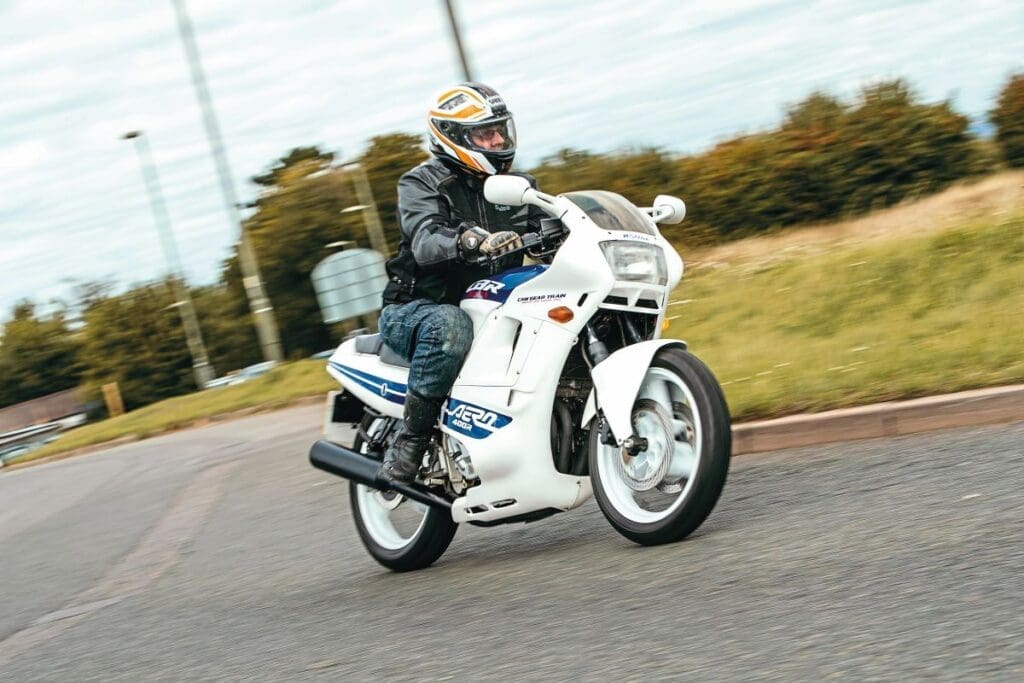
Words: Steve Cooper Pics: Gary Chapman, Mortons Archive
I’m back on a 400cc Japanese Domestic Market machine this time and one which may look very familiar to many of us.
Yes, we’re back in Surrey with JDM lover Dave Jupp. He is an arch proponent of these machines, bikes that, sadly, we were often denied, unless imported by the container load by grey importers, such as BAT Motorcycles, Pocket Rockets and the like.
This month it’s the turn of the Honda CBR400R Aero which many would claim was the top 400 offering from Honda at the time. Whereas the CB-1 and CB400 SuperFour we’ve covered previously were, arguably, multi-purpose machines aimed at covering more than one base, the Aero is a totally different tureen of aquatic fauna. The CBR400R is all about speed, or at least the allusion thereof, and is dressed in a ‘top hat and tails’ set of threads that leaves its cousins looking positively underdressed.
Where the CB-1 and SuperFour display their power units with pride and use them as a visual statement, the Aero does the exact opposite and masks the motor almost entirely. If you peek through the fairing infill panels on either side you can just catch glimpses of the twin-cam top-end, but those apertures aren’t there to gain points or bragging rights – oh no! Those two apertures perform a vital function. They and the pair of smaller slots behind them are there to exhaust all of the excess heat chucked out by the radiator and engine. In fact, those smaller slots are probably there to create a vacuum at speed which increases and enhances airflow. The only other parts of the power unit on show are the sprocket cover on the left and the tail-end of the clutch cover on the right. The front guard covers most of the forks’ lower legs; the bottom fairing panels partially enclose the outer pair of exhaust pipes; and hugger covers the top portion of the rear tyre. Now factor in the panelling around the seat and tail and it’s obvious that the bike’s sobriquet ‘Aero’ reflects the aerodynamic nature of the machine.
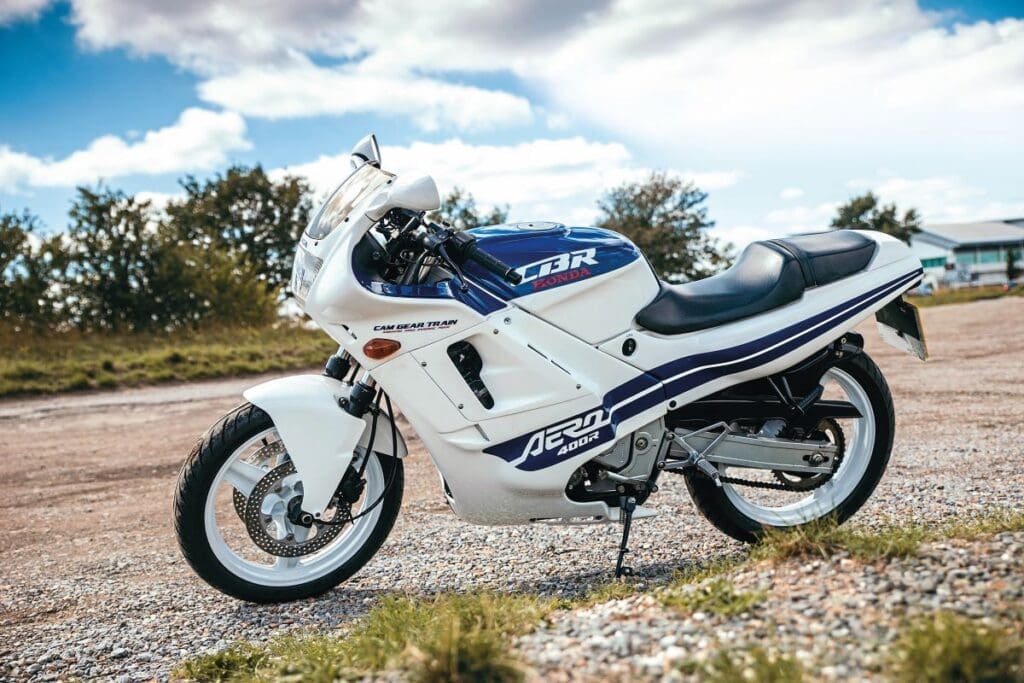
Remember we said you may find this shape familiar? Well, this silhouette was the basic shape for Honda’s 1987 CBR600F and CBR1000F machines, although the 400 pre-dates these by about a year. Over in Japan these machines were called ‘Hurricane’ and even came in 750cc size – which was also called the ‘Super Aero.’ Does that explain things? Good…
So then, the CBR400 Aero (and original 87 CBR600 and 1000) is part of what we Brits nicknamed the ‘jelly mould’ look. This pursuit of aerodynamic efficiency also extends to the indicators – the front pair poke out just sufficiently to be seen whilst the rears are effectively ‘frenched’ into the tail light assembly.
Under all that plastic is an extruded aluminium box section chassis with some high-end welding. The strong front alloy arms drop down towards the engine with a much thinner pair of reinforcing arms halfway down the box section. Rearwards of this are a pair of forged alloy dog-legs that form both the gearbox mountings and home the swingarm pivots. It’s a strong, yet lightweight, structure from which everything else is hung off including the engine which acts as a stressed member. Later models had a seriously strengthened swingarm badged as the ‘Tri Arm’ and later ‘Gull Arm’, but our test bike runs a much simpler box alloy swingarm that looks suspiciously similar to that of the CB-1. And I wouldn’t mind betting there’s a fairly conventional mono-shock from the same source attached to it. The seat and rear of the fuel tank locate on a set of triangulated rails that bolt to the rear the frame’s cast alloy section. In a nutshell the CBR400R’s chassis is light years away from both that of the CB-1 and SuperFour.
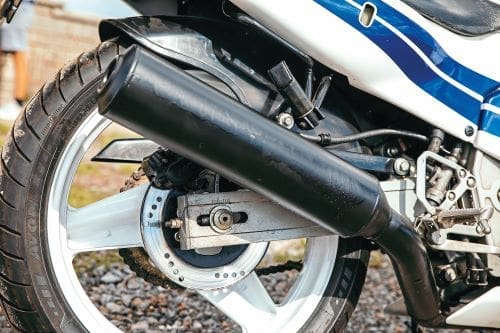
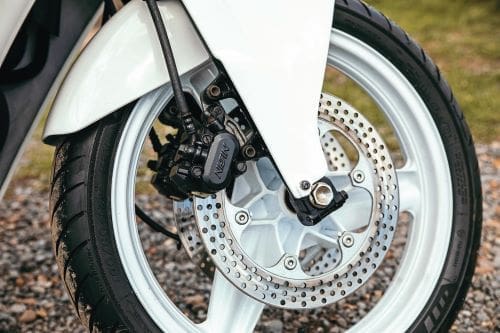

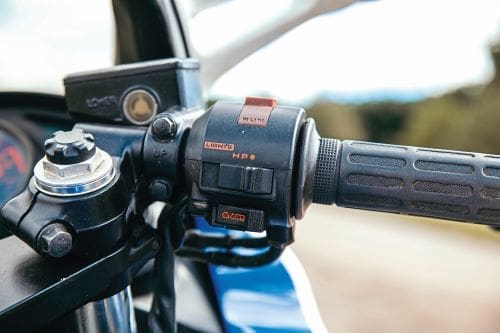
The heart of beast is, of course, the motor and this one is something rather special. It’s still a double overhead cam, liquid-cooled four with a quartet of valves per cylinder but this time the method of actuating the cams has gone up a gear (sic) – in fact it’s gone up by a factor of two! No cam-chains flailing around here thank you because the Aero’s top-end is actuated via a pair of gears mounted within a pair of parallelogram-shaped steel plates that take the drive from the centre of the crank to the gear train. The precision control derived from this expensive arrangement allows the Aero’s motor to red line at 14,000rpm as opposed to the 13,000 of the SuperFour’s; there’s also an extra six horses liberated, which is quite some achievement on a 400.
But enough techno-babble… what is it like to ride? Well, the first thing that strikes you is that the cockpit is snug, not exactly cramped but definitely snug. You grasp a pair of raised clip-on bars mounted to the fork stanchions that protrude through the top yoke; these, given their restricted adjustment because of tank and fairing, pretty much determine your upper body’s riding stance. And then there’s the hard, but supportive, seat which offers pretty much zero ability to shuffle around on at all. Finally there’re the foot-rests which are sited a lot higher than they seem to appear in our riding shots. To all intents and purposes the rider has to fit the bike but that’s generally the case with smaller race replicas – the pilot has to suffer for his/her art!
Where the previous CB-1 and CB400 SuperFour facilitated a decent amount of rider movement and discretion, the Aero is single focused – it’s there to be ridden hard and fast and I’m guessing the later and even more focused Tri and Gull Arms are even more extreme. Tucked in and faired away from much of the passing airstream, the bike simply eggs you on to explore the upper reaches of the tacho. That gear driven motor thrives on revs like you wouldn’t believe and relishes hard work.
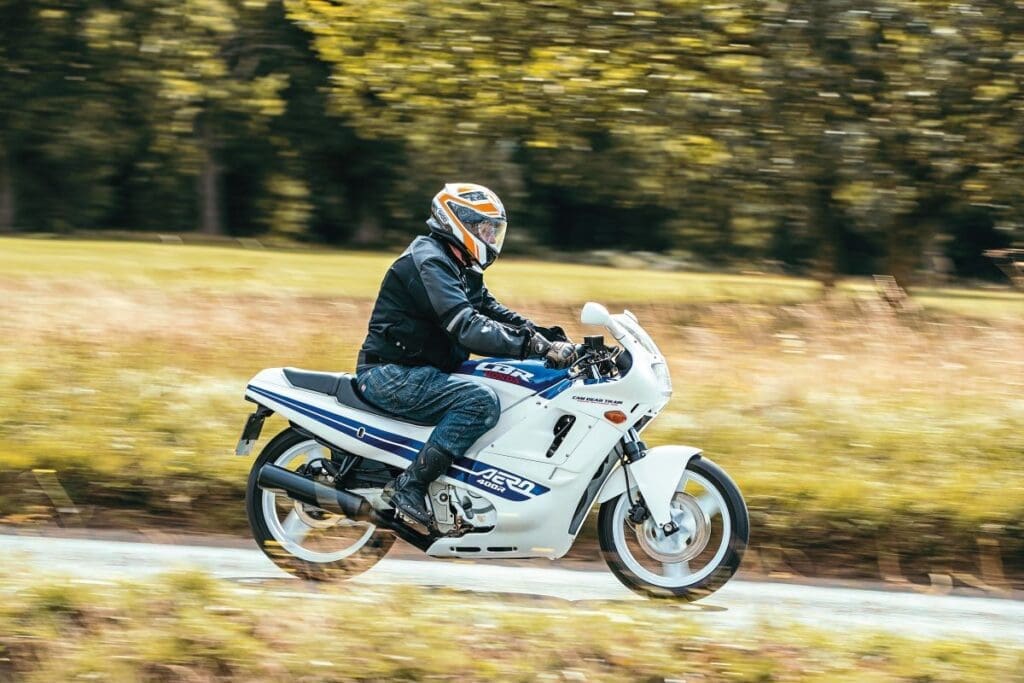
Comparisons to the firm’s CBR250RR are inevitable and the response is, ‘More of the same but better.’ Although not a torque monster, the 400’s motor has more grunt than the quarter-litre’s and doesn’t require quite so much caning to get up to speed – obviously enough…
That fairing does its job well enough and the only criticism I could churlishly throw at it is that it seems to reflect engine noise. But then when you have a bike so radically different to its peers some sacrifices have to be made. And talking of auditory experiences, oh, that exhaust note! As you step into the five-digit rev area the engine and exhaust take on an inspiring tone that only drives you on to explore the motor’s and gearbox’s potentials further.
Handling and braking are, as you’d expect, inspiring, and even the fairly acute riding position makes sense as the wind takes some weight off your wrists. Officially the bike is restricted to the JDM’s 112mph limit but, supposedly, there are simple ways around this and, duly unfettered, 135mph is achievable. Nothing of my test ride would indicate that the running gear would be fazed in the least by the additional 23 em-pee-aitch – the chassis is that good! The other liquid-cooled, inline 400/4s we’ve ridden in CMM are excellent machines in their own right but obviously not as focused as the CBR400R in camera.



Are any better or worse? Impossible to say because they are all targeted at entirely different markets. A fairer comparison is probably how the Aero and its analogues stack up against the supposed gold standard which is the VFR400? Honest opinion? Now I’ve ridden the Aero I have to say, despite all the tech in the V4, I prefer the inline four. To say it’s rawer than the V would be misleading but it somehow has more character. Yes, I’ll have an Aero please – yummy!

Honda CBR400R Aero: what is it like to own?
The owner’s view by Dave Jupp
“My friend Paul found a complete Honda Aero and half of one locally, the complete one painted Ford Yellow. This is the half bike rebuilt with a few parts from the yellow one and lots of eBay UK purchases. To be honest I was surprised just how many parts were readily available. Everything was stripped and inspected and I went through the engine to check all was well; given how high these motors rev it would have been stupid not to. I replaced every gasket and seal while it was apart including the 16-valve stem oil seals at £17 each. Sounds like a lot of money but I didn’t want to have to take off all the panels and strip the motor for a second time so considered the outlay a worthwhile investment. Talking of the panels, every single one needed repairs to lugs and fittings which took some time. It’s a good-looking machine in my opinion and really flies but it’s much more focused than either my CB-1 or SuperFour. The yellow bike is now also restored and just awaiting fresh paint when I can afford it.”
CBR400 Genealogy

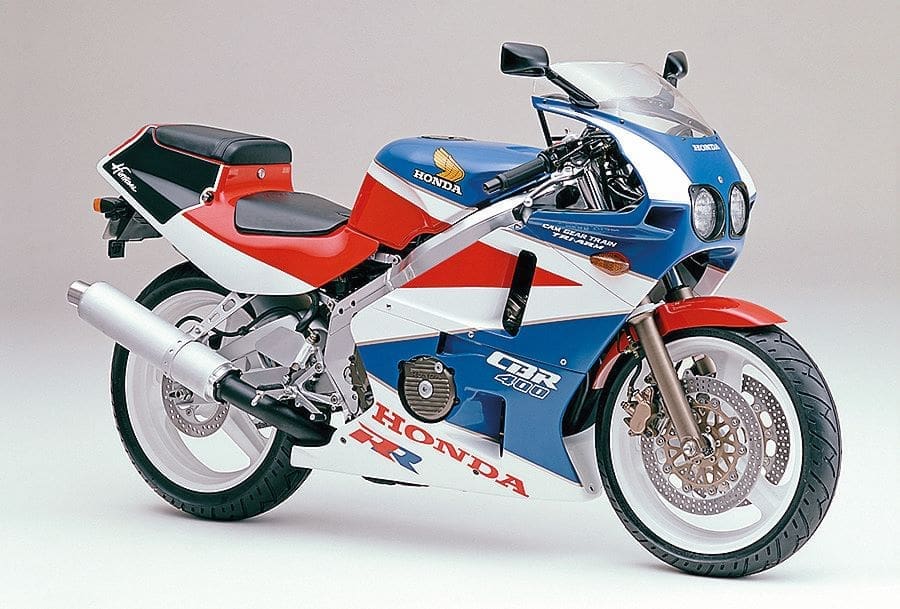
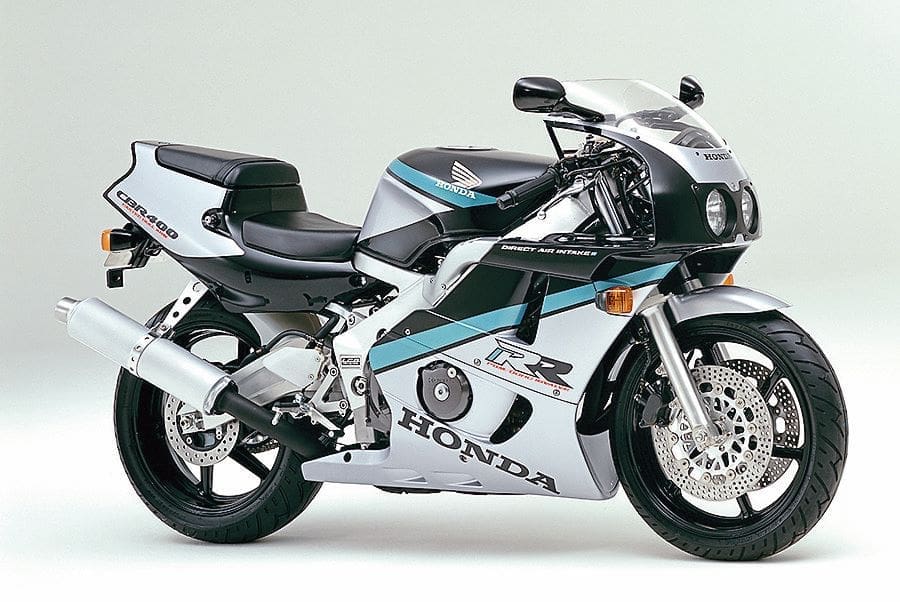
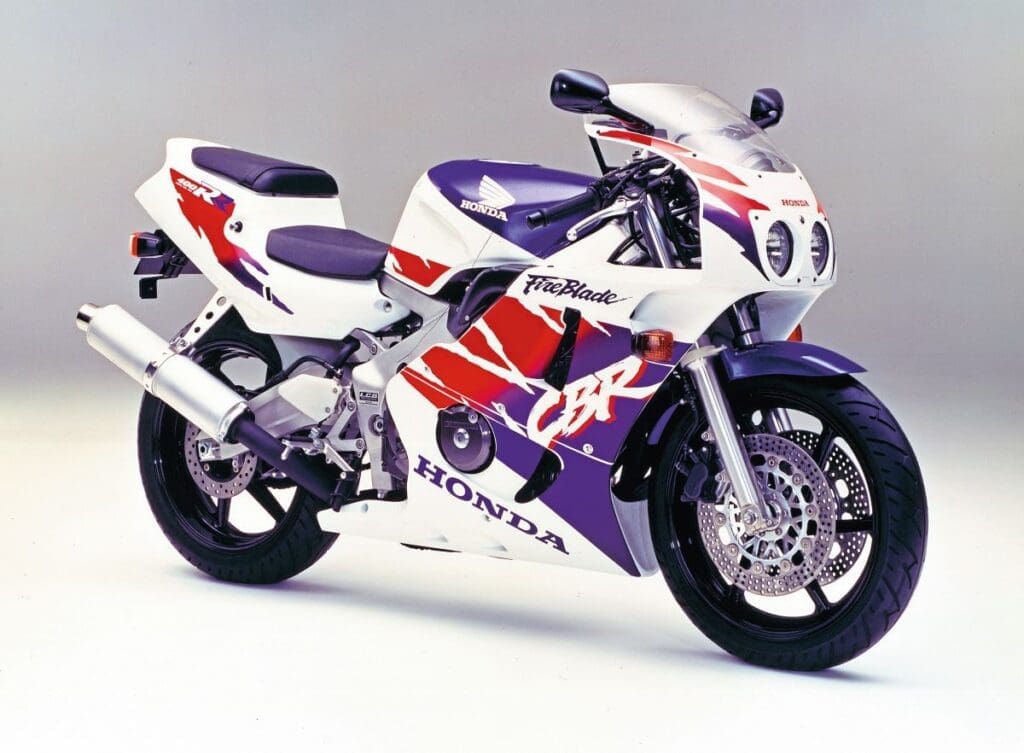
The CBR400 forms part of a long-running line of race-replica/faired middleweight Hondas that traces its ancestry back to the CBR400R (NC17)launched in December 1983.
Aimed at the top end of the hugely competitive Japanese 400 market, the bike was a forerunner of the much vaunted VTEC system called REV that delayed the opening of two valves below a certain rpm. Over the next couple of years the bike received both full and half fairings. There was a naked CBR400 – and these (with crash bars) were often used in Japanese riding schools. Of the half-faired CBR400s, we love the look of the ‘Endurance’ model, which, as the name suggests, looks much like some sort of late 1980s endurance racer. We reckon a big-bore version would sell well today…
1986 saw the arrival of our test bike in the guise of the NC23 CBR400 Aero which aped the fairing designs of the 600 and 1000 models sold in America as the Hurricane series. Then in 1987/1988 came the NC23 CBR400RR Tri-Arm (J and K models), with ally beam frame – again the ‘Hurricane’ logo was often on the tail unit before being dropped for 1989. Then in 1990 this was replaced with the Gull-Arm model (L, N, R) with the later models called ‘baby FireBlade’, thanks (in reality) just to the addition of the ‘FireBlade’ logo on the intake on the top fairing.
From late in 1999 the four-cylinder CBR400RR was deleted as a model, but the name was resurrected for a 400cc twin-cylinder family of machines from 2013.

Specifications
Engine type: 399cc liquid-cooled, four-stroke, inline, DOHC 16 valves
Bore and Stroke: 55.0 x 42.0mm
Claimed Horsepower: 59bhp @ 12,5000rpm
Maximum Torque:n28.7lb-ft @ 10,000rpm
Transmission type: 6 speed
Compression ratio: 11:1
Carburetion: 4 x 26mm flat
slide CV
Tyres: 110/90 x 16 (F)
130/70 x 18 (R)
Fuel Capacity: 3.2 gallons (14.5 litres)
Brakes: 2 x 270mm disc (F), 280mm disc (R)
Wet weight: 165kg (364lb)



